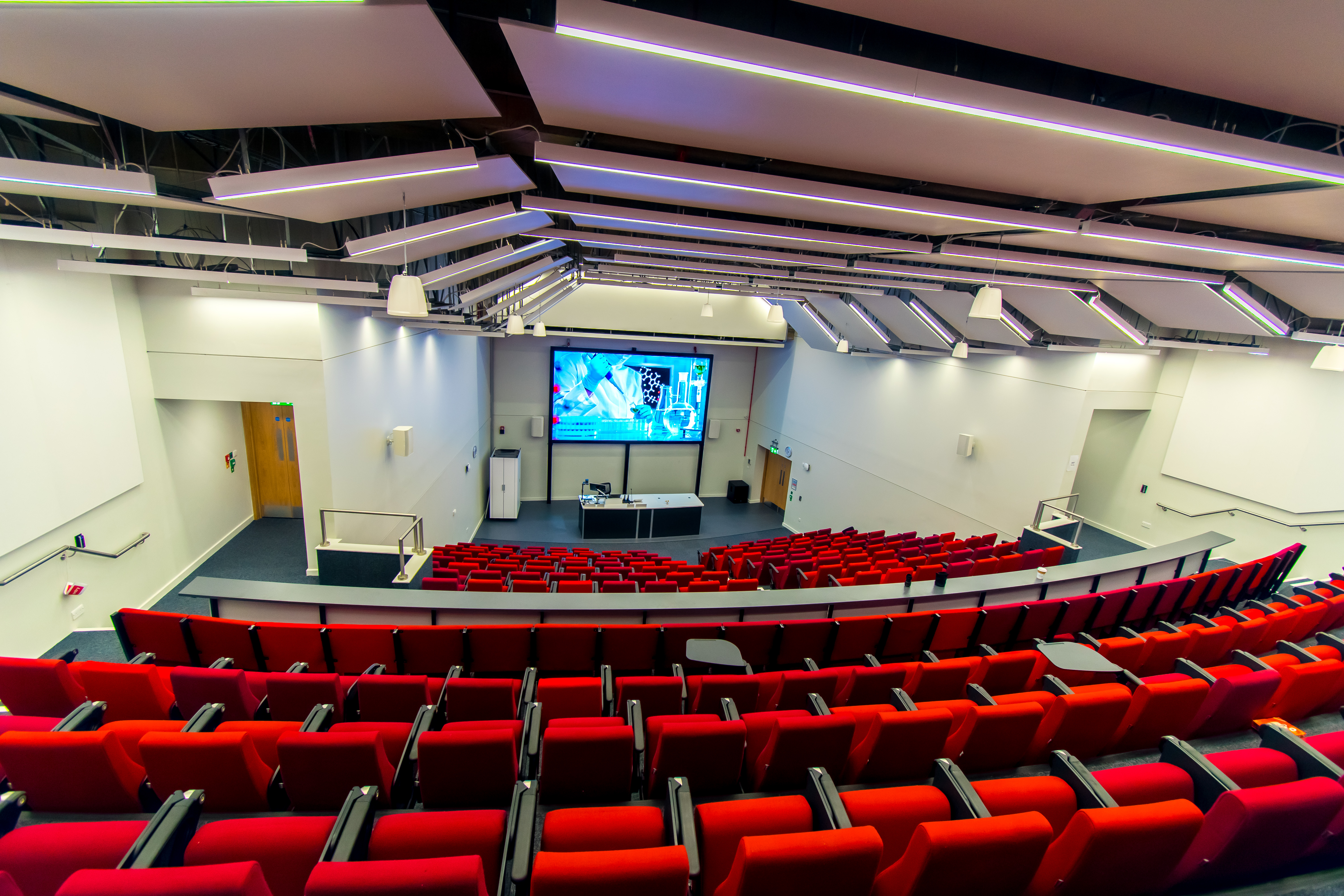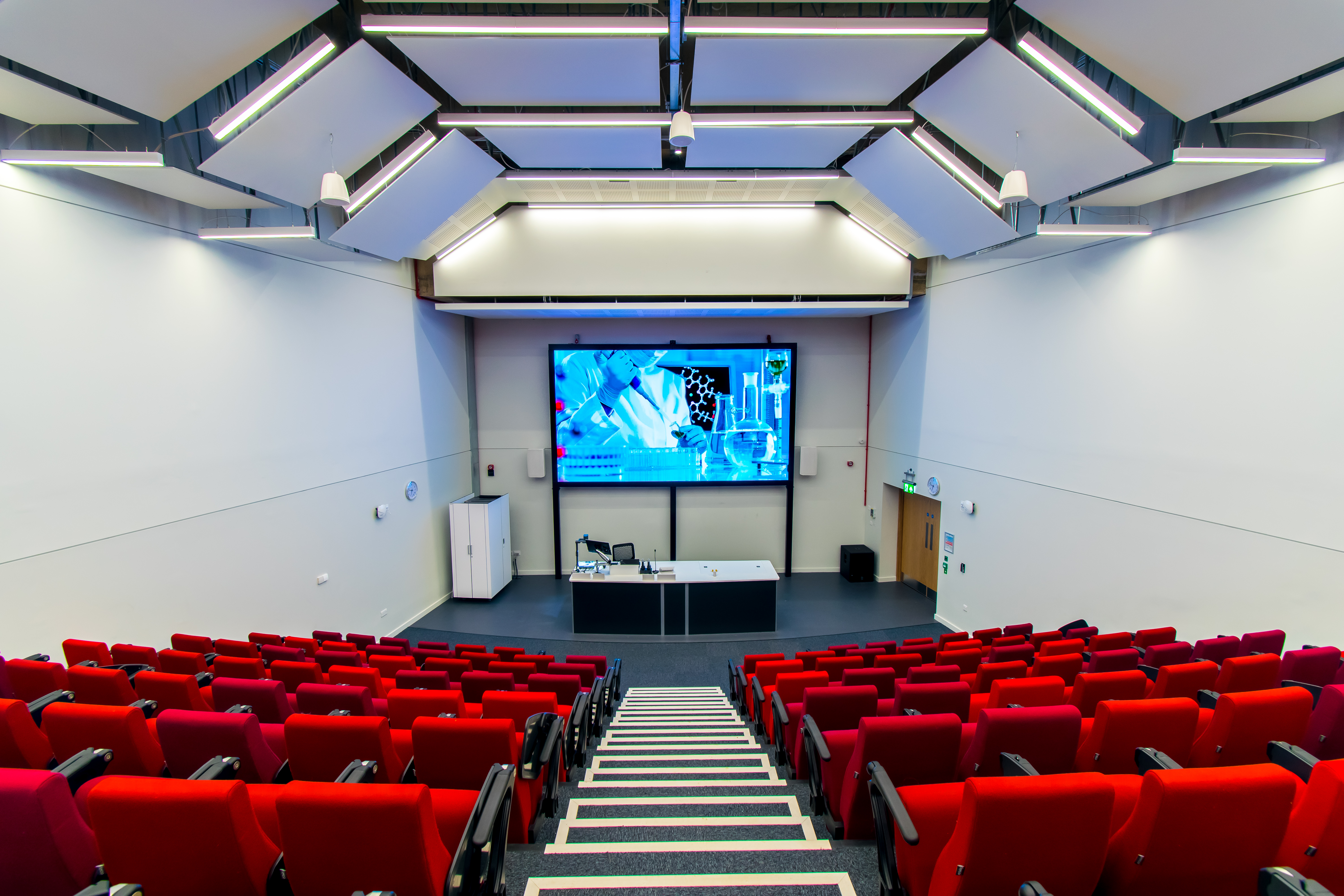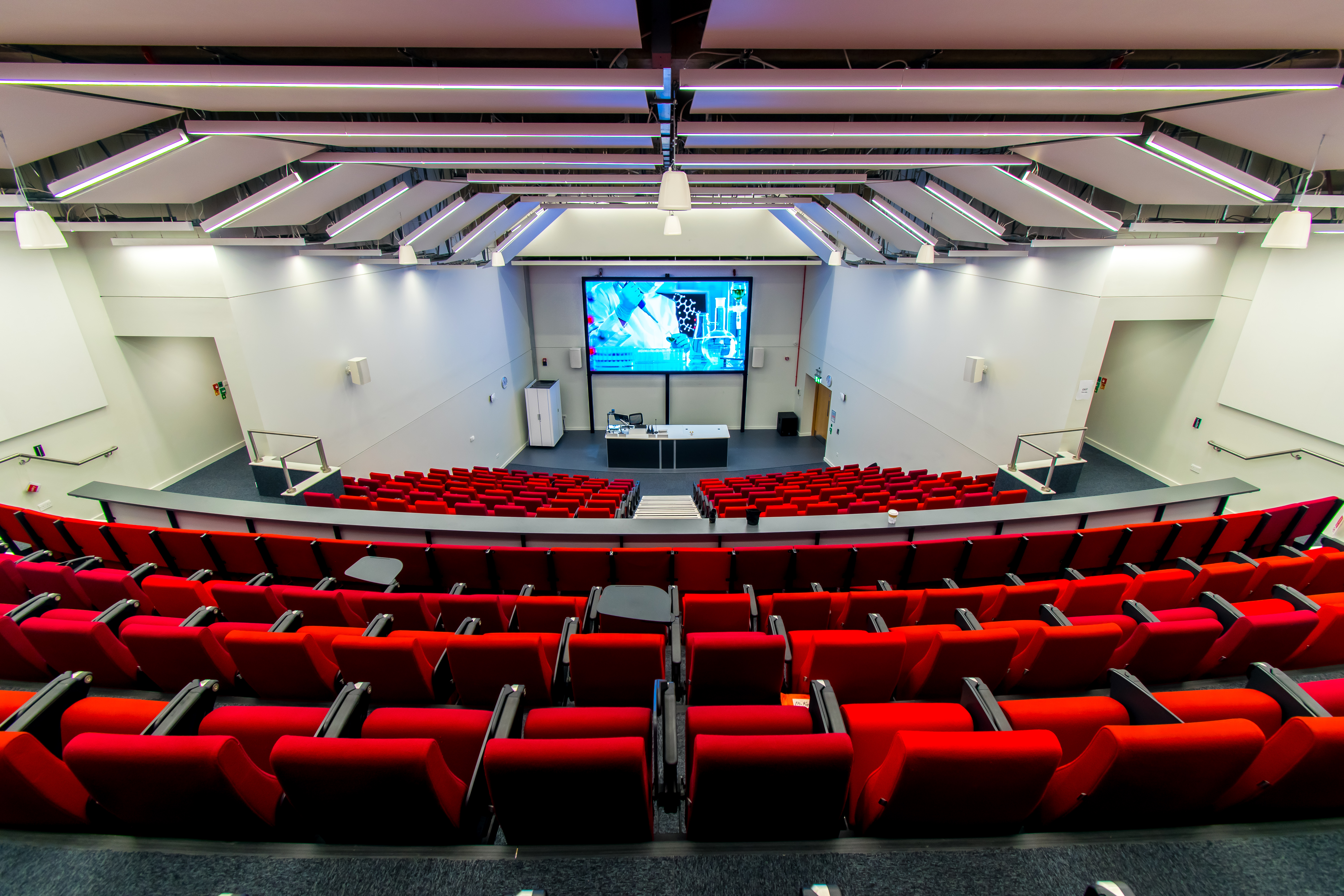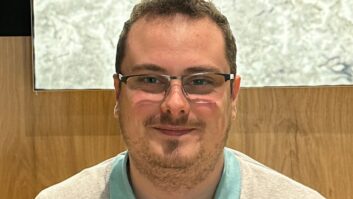
With student numbers up 51 per cent since 2007, the Anglia Ruskin University in Cambridge has had to find new ways to help accommodate an increasing demand for its classes and specialised teaching spaces.
The university recently opened its ‘Science Centre’ building, a £45 million facility, bringing together teaching, postgraduate and staff facilities for all six research departments within the Faculty of Science and Technology- Biomedical Science/Forensics, Computing and Technology; Psychology and more.
Requirements ranged from small and large groups as well as individual one-to-ones. Each of these departments have highly specialised spatial requirements for technical training, which the building and its AV infrastructure were categorically designed to meet.
Previously, teaching was accommodated in a variety of spaces scattered across the campus, which led faculties and departments to become fragmented over time, straining the overall estates strategy and posing concurrent timetabling challenges.
Snelling Business Systems were involved in the specification, design, installation and commissioning stages of the project.
The client brief:
• Scale-up the hugely successful Superlab concept (ARU Chelmsford campus, 2015) to accommodate up to 200 students, and capable of delivering up to four separate lectures simultaneously.
• 294-seater lecture theatre to accommodate larger cohorts attending theoretical lectures all at once.
• Find a solution to the challenges posed by the lack of projection position in the lecture theatre.
• Find a solution to latency in the deployment of AV over IP across the new development.
The brief lays specific focus on flexibility: In the sense that the physical location of the student and lecturer does not matter anymore.
For example, at the Superlab, whether a student arrives late to the lecture, or when the student is not sat at the same bench as the lecturer – they can start and finish the lecture without a hassle or interruption.
“With the Science Centre we set out very clear objectives – technology solutions for highly flexible teaching and learning spaces,” said Matt Hall, multimedia infrastructure engineer at Anglia Ruskin University. “We sought solutions that were instinctive to use and designed to meet the specialised training needs in the building.”

Here’s a breakdown of each space:
SUPERLAB:
One lab, 200 students, four separate lectures simultaneously.
The system provides four lecturer positions, and each lecturer position is also equipped with the following inputs:
• Main (fixed) PC
• USB connections X2 (connected to installed PC)
• Go-Pro camera
• Laptop HDMI
• Laptop VGA + Audio
• Presenter Camera

Each lecturer position is equipped with a high-res camera facing the lecturer, an installed PC and GoPro Camera (ideal for environments handling corrosive chemicals and water) on a snake mount.
SUPERLAB AUDIO
For up to four simultaneous lecturer sessions taking place at any time, audio distribution is via radio frequency headphones available to each student.
Each lecturer also has a ULXD digital wireless microphone transmitter, which is distributed wirelessly, along with any content from the lecturer fixed PC, laptop or other connected audio source.
Microphone feeds are received by a ULXD4Q Quad receiver, with antennas mounted at high level within the laboratory, and the receiver unit in the main AV rack.
Presentation audio from the lecturer PC’s / Laptops runs along with the video feed over CAT6A infrastructure to the main AV rack.
The presentation audio is then de-embedded and mixed with the radio microphone feeds via a DSP matrix unit. The mixed feeds are then re-transmitted as four FM channels via an Audeon multichannel transmitter unit. Transmission antennas for the Audeon unit are mounted at high level within the laboratory space.
Students use a clip-on radio receiver to select one of the four lecturer audio feeds. These receivers are compatible with ‘personal induction loops’ which provide for DDA compliance.
“While there were several options, we explored unconventional ideas,” said Hall. “The perfect solution was found in an increasingly popular application within gyms and other recreational areas.
“Direct-to-User radio broadcasts allow gym-goers to choose from a host of proprietary music channels provided by the gym or radio stations. Users can simply plug in their personal headsets and access HQ stereo content while at the gym. This was a perfect match to the end-user application at the Superlab.”

SIGNAL DISTRIBUTION:
- Main AV Rack to/from Screens
- Signal distribution between the main AV Rack and
- Screens is over CAT6A STP certified cable systems with a total of 16x points.
- Four RF coax cables (RG213) run from the main AV rack to a high-level
- position in the laboratory to connect the antennae for wireless systems.
- Within Lecturer benches Each of 4 lecturer benches house one Middle Atlantic
12U height rack system and installed in a 19” rack sub assembly. Signal distribution within lecturer benches are over pre-terminated HDMI cables, while one HD-BaseT feed is sent from the lecturer bench to the central AV rack position.
MAIN LECTURE THEATRE
The AV infrastructure of this lecture theatre is specified and designed to be entirely user-operated, and therefore there isn’t a technician booth.
The physical dimensions of the space preclude the use of projection equipment entirely. Therefore, the solution was a large High Definition LED display.
- 4610 x 2590mm LED Display system capable of up to Full HD resolution
- Provides the ability to display single content or two different pieces of content side-by-side
- Capable of working with input resolutions to 1080p
- Vitreous Enamel Whiteboards also cover the presentation wall under the main screen
- Compliant with Infocomm standards for viewing angles at all seating positions.
The front furniture is a bespoke lab bench, with audio visual systems incorporated as follows:
- 1x Extron 10” Touch screen controls all audio visual equipment.
- Input points for HDMI, VGA + audio and CV + audio signals2x USB Connection’s (connected to installed PC)
- Permanent PC with Sharp interactive display Wired and Wireless KB/Mouse
- Ability to preview all sources before going live to main screen
- Provision for BYOD Hardware
- Beyerdynamic Condenser Speech Lectern microphone and Shure Wireless Microphones (2x handheld & 2x lavaliere)
- 1x Wolfvision Full HD desktop visualizer
- Go-Pro camera on flexible SnakeClamp mount and gooseneck arm.
- Denon DN-500BD Professional Blu-ray player
- 1x Echo SafeCapture Pro for lecture capture capabilities.
- Cisco Video Conferencing CODEC and Cisco Telepresence PrecisionHD Camera

AUDIO
- Voice reinforcement from lectern, handheld and lavaliere microphones via dedicated system
- Ampetronic HOH loop system with the ability to operate independently from main AV system
- Extron Full 7.1 channel system for presentation audio
- Dedicated Record Output
- The audio capabilities are specified to perform the following functions:
- Voice reinforcement from lectern, handheld and lavaliere microphones via dedicated system
- Ampetronic HOH loop system with the ability to operate independently from main AV system
- Extron Full 7.1 channel system for presentation audio
Dedicated Record Output
2 x Beyer MPR211 microphones installed at a height feed the DMP128. These are configured to operate independently of the AV system for Assisted Hearing and Lecture Capture purposes.
ULXD digital wireless microphone transmitters are received by two ULXD4 receivers- antennae are mounted at a height within the theatre, and the receiver units are mounted in the equipment rack.
Presentation audio from the lecturers PC / Laptop is fed along with the video feed to the HDMI matrix; the audio from a discreet output from the matrix is de-
embedded and presented to the DSP as a stereo program feed. The stereo program feed may be configured to ‘follow video’ or as ‘breakaway’.
An output from the HDMI matrix is fed to a professional 7.1 surround decoder, this is used to feed the Blu-Ray players 7.1 audio to the DSP’s.
VIDEO CONFERENCING
The Video Conferencing CODEC’s program audio output is fed independently to the DSP’s; this allows the correct content audio to be routed through the HDMI matrix.
The Video Conferencing CODEC’s microphone input is fed independently from the DSP’s; this allows for ‘per microphone’ AEC rather than rely on the CODEC’s internal AEC.
The assistive listening facility uses the Audio Frequency Induction Loop System (AFILS) Specifically an Ampetronic MLD7.
CONTROL & SWITCHING
• Extron IPCP Pro 550 control processor
• Extron DXP HD 4K matrix switcher with audio de-embedding
• Extron DVC RGB to HDMI Converter audio embedding
• Extron HDMI distribution amplifier
• Cisco Telepresence Touch 10 touchscreen interface
• Cisco 12 port and 16 port switches
OTHER TEACHING SPACES
TRAINING ROOMS
The system provides one lecturer position; audio visual content from this position is displayed on a 55” LCD flat panel.
The lecturer position is equipped with an installed PC and the following inputs:
✓Main (fixed) PC
✓Laptop HDMI
✓Laptop VGA + Audio
The lecturer position also has two auxiliary inputs (HDMI & VGA with Audio) for the connection of laptops or other devices.
The system can be operated via a push button control panel, which will allow the routing of any input to the screen.
The control panel can also control the volume of each input when in use.

MEETING ROOMS
The lecturer position is equipped with one 9-button fixed control panel connected to the LAN, this panel allows:
✓Input selection (ARU standard for VC rooms)
✓Volume control
✓On/Off
Audio visual content from the Video Conferencing Codec is displayed on a single wall mounted 55” Panasonic LCD flat panel.
Two auxiliary inputs (HDMI & VGA with Audio) will be available for the connection of laptops or other devices.

CLASSROOMS
There are three types of classrooms at the Science Centre, differentiated by their physical layouts.
The specifications of the AV infrastructure are fully standardised and designed to effortlessly adapt to physical characteristics of each room type.
The system provides one lecturer position, and audio visual content from this position can be distributed to the NEC 5000 ANSI projector (1920 X 1080 resolution) and two NEC 46” FHD relay screens.
A fixed frame projection screen is mounted on the wall facing the students accompanied by one speaker (QSC AcousticDesign surface mount speakers) either side dispersing the left/right audio signals.
Content can also be sent to an interactive touch display to act as a Preview monitor and PC Monitor.
The lecturer position is equipped with the following inputs:
✓Main (fixed) PC – 2 outputs used
✓Document Camera
✓Laptop HDMI
✓Laptop VGA + Audio
✓Laptop LAN Connection
✓USB Connection’s X2 (connected to installed PC)
✓Blu-Ray Player

“I can confidently state that our objectives have been fully met,” said Hall, summing up the installation. “For example, the new lecture theatre LED Display provides incredible quality and clarity, with the capabilities to present contrast ratios and definition that simply would not have been possible using a projector-based system.
“Immersive audio and a naturalistic control system allied with reliability and flexibility of use provided by the hardware components provide our University with a highly functional space that also has the ‘wow’ factor.”










